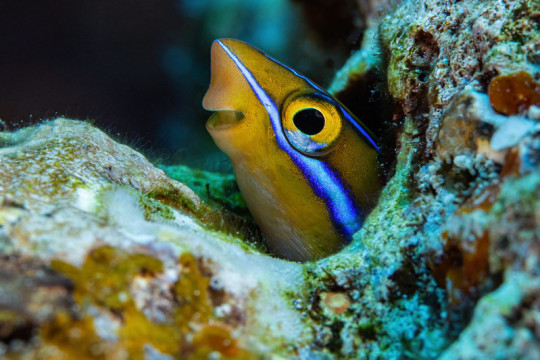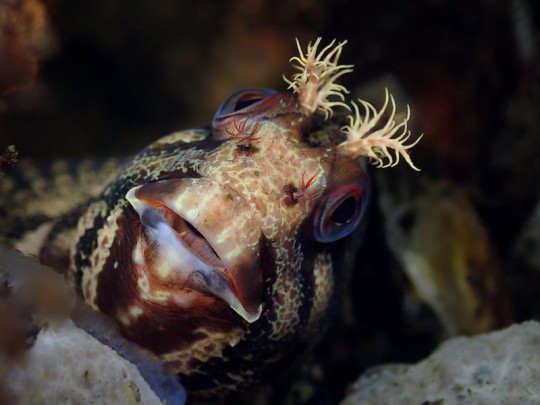#Blenniidae
Explore tagged Tumblr posts
Text

A bluestriped fangblenny (Plagiotremus rhinorhynchos) peeks out of a coral reef in Fiji
by divindk
#bluestriped fangblenny#say that 3 times fast#combtooth blennies#blennies#bony fish#fish#plagiotremus rhinorhynchos#plagiotremus#blenniidae#blenniiformes#actinopterygii#chordata#wildlife: fiji#wildlife: oceania
102 notes
·
View notes
Text

Tasmanian Blenny (Parablennius tasmanianus), family Blenniidae, poking its head out of an old Barnacle on a jetty pylon.
photograph by Steve Jones
51 notes
·
View notes
Text

Blackflap Blenny
#blackflap blenny#blenny#Cirripectes auritus#fish#Actinopterygii#Blenniiformes#Blenniidae#Cirripectes#upl
10 notes
·
View notes
Text
i actually am not as fond of clinidae and labrisomidae and ofc blenniidae is a very large family but who am i to say what’s best anyway we’re all just creatures of earth
5 notes
·
View notes
Photo

Photo by Adam Hanlon | Info
The black comb-tooth blenny or Namiye's coral blenny (Ecsenius namiyei) is a species of marine fish in the family Blenniidae. The specific name honors the Japanese zoologist and museum curator Motoyoshi Namiye (1854-1915). The black comb-tooth is widespread throughout the tropical waters of the western Pacific Ocean from the Philippines to Solomon Islands. It grows to a size of 11 cm in length.
#ecsenius namiyei#black comb-tooth blenny#Namiye's coral blenny#blenny#blennies#fish#reef fish#marine biology#blenniidae#marine photography#underwater photography
94 notes
·
View notes
Text
Blénido Estrellado (Salarias ramosus)
Blénido Estrellado (Salarias ramosus) cuidados y características 🐠 #EnTuAcuario #BlenidoEstrellado #SalariasRamosus #PecesMarinos #Acuario #Pecera #AcuarioMarino #Acuariofilia #Aquariofilia
El Blénido Estrellado (Salarias ramosus), lo encontraremos distribuido por todo el Pacífico oeste, desde el Noroeste de Australia asta Filipinas. Normalmente se encuentran cerca de las barreras de coral a unos 15 metros de profundidad. Pertenece al género Salarias y a la familia de las Blenniidae. Características El Blénido Estrellado se trata de un pez con un cuerpo alargado que posee…

View On WordPress
#Blénido Estrellado#Blenniidae#peces acuario#peces agua salada#peces marinos#Salarias#Salarias ramosus
1 note
·
View note
Text
Salarias fasciatus: l'instancabile pesce mangia alghe dell'acquario marino
Salarias fasciatus: l'instancabile pesce mangia alghe dell'acquario marino - La Salarias fasciatus è un simpaticissimo pesce che fa parte della famiglia dei blennidi, uno dei pesci più buffi in assoluto, ma anche uno dei più utili nella lotta contro le alghe in un acquario marino.
Un nuovo articolo su http://www.danireef.com/2021/05/28/salarias-fasciatus-linstancabile-pesce-mangia-alghe-dellacquario-marino/
Salarias fasciatus: l'instancabile pesce mangia alghe dell'acquario marino
#Alghe, #AlgheInAcquario, #Blenniidae, #Pesci, #PesciMarini, #SalariasFasciatus
- by Danilo Ronchi
0 notes
Text
Plagiotremus rhinorhynchos
Plagiotremus rhinorhynchos Plagiotremus rhinorhynchos es una especie de pez de la familia Blenniidae en el orden de los Perciformes. https://acuariossanmiguel.online/peces-e-invertebrados-marinos/ Los machos pueden llegar alcanzar los 12 cm de longitud total. Los adultos de color variable, que van del negro al amarillo con 2 rayas azules en el cuerpo Es un pez de mar y de clima tropical y…

View On WordPress
0 notes
Text

A tompot blenny (Parablennius gattorugine) off the coast of the Netherlands
by Verheyen Stefan
#tompot blenny#blennies#bony fish#fish#parablennius gattorugine#parablennius#blenniidae#blenniiformes#actinopterygii#chordata#wildlife: netherlands
158 notes
·
View notes
Photo

Midas Blenny by Chethan_Fotobuzz Ecsenius midas, known commonly as the Midas blenny, Lyretail blenny or Golden blenny, is a species of marinefish in the family Blenniidae. The Midas Blenny is an excellent candidate for a reef tank. It is a beautiful, deep golden-yellow with a shadow of blue under the chin and bright, blue-rimmed eyes. The Midas blenny is widespread throughout the tropical waters of the Indo-Pacific area from the eastern coast of Africa, Red Sea included, to the Marquesan Islands.
11 notes
·
View notes
Photo

False Mudskipper
Kingdom: Animalia
Phylum: Chordata
Class: Actinopterygii
Order: Blenniiformes
Family: Blenniidae
Genus: Neoalticus
Species: N. pacificus (”Pacific new Alticus [a genus of combtooth blennies]”)
Ancestral species: Alticus arnoldorum (Pacific leaping blenny)
Time period: early Lithocene to late Solocene (65 million years to 140 million years in the future).
Information: a rather long-lived species of blenny, the False Mudskipper gets its name from its superficially mudskipper-like appearance, despite being only distantly-related to it. Found primarily along the shallow coastlines of eastern Thalassia and western Occidensia, this animal feeds primarily on algae, but will also go for small crustaceans and smaller fish. It is especially common around tide pools, and is an essential part of the oceanic ecosystem. Its front fins allow it to essentially walk on land, and it can survive on land for as long as 3 days. At around 6 inches in length, it is fairly large for an amphibious fish. In color, it is a light greenish-yellow with light brown stripes on the head which turn into faint stripes further down on the body.
0 notes
Text
How to be a fish out of water
Animals have evolved some incredible adaptations to survive, especially those that moved from water to land – but these can come at a cost.
After leaping out of water to escape nasty predators, cunning species of blenny fish (Blenniidae) then had to adapt to limited food choices, reports a study published in the journal Functional Ecology.
“We found having a broad diet and being behaviourally innovative or flexible has been a precursor to blenny fishes emerging from water for a life on land,” says lead author Terry Ord from the University of New South Wales.
But running into food restrictions triggered major changes in their morphology, especially their teeth, as they were forced to adapt into specialised rock scrapers to forage on algae and detritus.
To flourish on land, therefore, blennies went from being a “jack-of-all-trades” to a “master-of-one”, write Ord and his collaborator Peter Hundt, from the University of Minnesota in the US.
Fossils from hundreds of millions of years ago, back to the Late Devonian, have helped scientists glean insights into the evolutionary adaptations of aquatic animals as they made the radical transition to land.
Modern-day blennies present a unique opportunity to see this evolutionary transition in action, Ord says.
While some species are happy to stay in the water, others that have ventured out divide their time between water and land, in the intertidal zone with fluctuating water levels and pools prone to rapid changes in temperature and oxygen levels.
Land blennies spend virtually their whole lives out of the water, but they stay in the splash zone to keep moist so they can breathe through their skin and gills. They defend territories, court each other and reproduce exclusively out of water.
Ord bonded with Hundt over their mutual fascination with the fish. “We both had extensive data collected on many, many different species of blenny from across the world,” he says.
“Peter had detailed information on diet and teeth morphology, while I had lots of data on behaviour and frequency of different species emerging from water for brief or extended periods on land.”
Pooling their data, they used complex evolutionary statistical models to shed light on the sequence of events that allowed blennies to make the transition, and how the species on land adapted to the specialised diet needed to survive.
Their findings could have broader implications, Ord notes, especially with the planet’s rapidly changing climate.
“[S]ome species that are already uniquely specialised to their existing environment are probably less able to make further transitions in habitat or might not cope well if abrupt changes occur in their environment,” he says.
The study is observational, so the pair is hoping to dream up a way to test their findings experimentally. They’re also curious about other adaptations.
“Terrestrial blennies are really agile out of water,” says Ord, “and I suspect they’ve adapted their body shape to allow them to hop about the rocks so freely. Which in turn implies they might not be able to go back to the water.
“It would also be exciting to know how their sensory systems might have adapted out of the water as well, given vision and smell would probably work quite differently in these environments.”
The post How to be a fish out of water appeared first on Cosmos Magazine.
How to be a fish out of water published first on https://triviaqaweb.weebly.com/
0 notes
Text
Bu balıklar, karada hayatta kalmak üzere evrimleşirken yakalandı.
https://www.bilimgunlugu.com/?p=6841&utm_source=SocialAutoPoster&utm_medium=Social&utm_campaign=Tumblr Blenniidae familyasından çılgın hareketler görüyoruz. Bu balıklar, karada hayatta kalmak üzere evrimleşirken yakalandı., https://www.bilimgunlugu.com/?p=6841&utm_source=SocialAutoPoster&utm_medium=Social&utm_campaign=Tumblr
0 notes
Text
Horozbina Balığı Özellikleri
Perciformes takımının Blennioidei alttakımının Blenniidae familyasını oluşturan, büyük bölümü sıcak ve ılık denizlerde, pek azı tatlı sularda yaşayan 300 kadar kemiklibalık türünün ortak adıdır. Uzunlukları türe göre 2,5-30 cm arasında değişen bu balıkların vücudu pulsuz ve kuyruğa doğru giderek basıklaşan uzun bir koni biçiminde, başı kısa ve küt, gözleri iri, ağzı küçük, dudakları kalındır.…
View On WordPress
0 notes
Photo

great resouce for identifying what you see This oversized book has photographs! And they are not dead fish photos, but fish in their environments. It's very useful because all your choices are on the same page(s), so you can more easily lock on to what you saw. I do miss the use of common names and depth, but it does include the area where the fish is found and where the photo was taken along with the scientific name. Before finding this book, I was using one with line drawings. This is a big improvement and I've been able to find fish from the Gulf of Aqaba that I saw on a recent vacation. I snorkel all around the world, so wanted to have Atlantic and Pacific species. Go to Amazon
Good picture reference: Extensive but not exhaustive content. Very good catalogue of fish for those who seek an overview of all families. One or two more infos would be sometimes helpfull (sex, size). Some families are underrepresanted (Gobiidae, Blenniidae) but including all of them would have been difficult as they are huge families. I would recomend using it as a first identification source (not on the field though...big!) and then switch to a more specialized book providing more infos about the species. A must have for all marine fish enthusiast! Go to Amazon
0 notes
